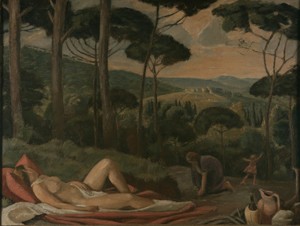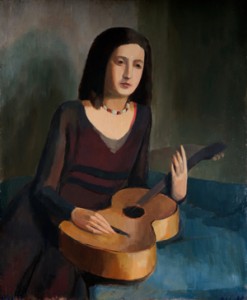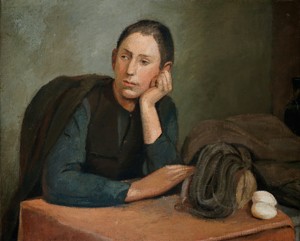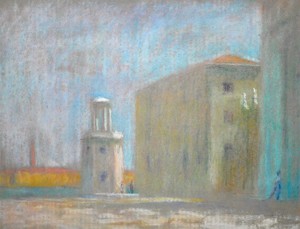© Hans-Joachim Staude, Venera bel bosco / Venus in the woods, 1937
An exhibition and a conference in Venice to commemorate the work of the German artist on 18th November 2015, the island of San Giorgio Maggiore in Venice inaugurates an event dedicated to the German painter Hans-Joachim Staude (Haiti 1904 – Florence 1973), who distinguished himself in Florence in the 1900s, in the light of new interpretations and his unpublished writings.
The exhibition has been organized by his son and daughter, Jakob Staude and Angela Staude Terzani, in collaboration with the Giorgio Cini Foundation and is curated by Francesco Poli and Elena Pontiggia.
For five days, the Sala Piccolo Teatro will be hosting the exhibition, consisting of 27 paintings – portraits, landscapes, still lifes – painted between 1929 and 1973, and will also be running a conference (18th and 19th November) involving 11 art historians, Italian and other, who will present further research that helps rediscover the importance of this painter within the context of Italian art of the 1900s.
© Hans-Joachim Staude, Ragazza con Chitarra / Girl with Guitar, 1929
Hans-Joachim Staude, was one of the most interesting painters of his generation, who is still little known in Italy.
27 paintings carefully selected by Francesco Poli and Elena Pontiggia, document his personal artistic evolution amidst the many influences of Italian art of the 1900s, and reveal his precise stylistic currency and originality which make him one of the most « Italian » among German painters of the twentieth century.
Born in Haiti to German parents, Staude was educated in Hamburg, where in 1918 he saw the first major exhibition of Edvard Munch. After coming in contact with the German Expressionism of the ‘Brücke‘, a time when his research was marked by a subtle introspective dimension and a strong philosophical inspiration, in 1920 he decided to devote himself to painting.
In 1929, after a year of studying in Munich, and several to Florence, Hamburg and Paris, where he was influenced by French Impressionisms, Staude settled in Florence, where he worked for the rest of his life, absorbing the « modern classicism » of Italian art between the wars, from the likes of Ardengo Soffici and Felice Carena.
© Hans-Joachim Staude, Il ragazzo con le uova / The young man with eggs, 1934
« A series of figures of intense plasticity, that appear almost sculpted rather than painted, belong to this period, and the following decade” – say the curators Francesco Poli and Elena Pontiggia – “Equally, there are landscapes that were painted in the classic manner, which transcend the sense of the moment of Impressionism and go beyond the passing of time; there is a series of still lifes, in which Staude’s German culture resurfaces with the introduction of symbols of the ephemeral and death.
The artist uses a distinctive introverted yet intense colour palette that is both elegiac and lyrical.
His Expressionist training, though outgrown by him, lends his paintings something different and makes them in some ways unique in the period. »
In 1996 Palazzo Pitti dedicated a major retrospective to the work of Hans-Joachim Staude, which placed him in the panorama of Italian art of the twentieth century.
© Hans-Joachim Staude, Il faro di san Giorgio Maggiore / The light house of san Giorgio Maggiore, 1971
What is missing, however, is a more accurate critical study of his close connection with twentieth-century Italian painting; the conference of art historians inends to address this omission.
On 18th and 19th November, at the Sala Piccolo Teatro of the Cini Foundation, the following scholars and critics will be taking part in discussions: Thomas Baumeister, Radboud Universiteit, Nijmegen, Netherlands; Nicoletta Colombo, Studio D’Arte, Milan; Lorella Giudici, Accademia di Brera, Milan; Francesco Poli, Accademia di Brera, Milan; Elena Pontiggia, Accademia di Brera, Milan; Susanna Ragionieri, Accademia della Belle Arti, Florence; Matteo Sapienza, art historian, Milan; Carlo Sisi, former Director of the Galleria d’Arte Moderna at Palazzo Pitti, Florence; Nico Stringa, Universita’ Ca ‘Foscari, Venice; Monica Vinardi, art historian, Savona; Reinhard Wegner, Friedrich-SchillerUniversity, Jena, Germany.
The papers presented at the conference will be published in an illustrated book dedicated to the work of Hans-Joachim Staude, together with a wide range of reflections on art taken from diaries, letters, and unpublished notes of the artist himself.




 Entrez votre email pour être toujours au courant des nouveautés !
Entrez votre email pour être toujours au courant des nouveautés !